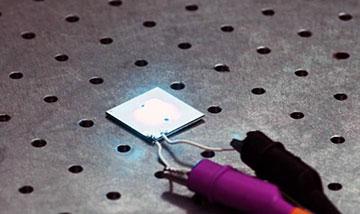
A quantum-dot (QD)-based white light-emitting diode exhibits a record-high efficiency thanks to QDs that are suspended in solution rather than embedded in a solid. [Image: Sedat Nizamoglu / Koç University]
A team of engineers from Koç University, Turkey, has demonstrated an optofluidic approach to manufacturing white liquid-state quantum-dot light-emitting diodes (LQD-LEDs) with a luminous efficiency as high as 105 lm/W—a 50 percent improvement over standard solid-state QD-integrated white LEDs (Optica, doi: 10.1364/OPTICA.5.000793).
The LQD-LED consists of a silicone lens on top of a blue LED chip. The pocket of the silicone lens is filled with optimized cadmium-based QDs suspended in a liquid. The cadmium-based QDs absorb some of the electroluminescence emitted by the blue LED chip and emit red and green light. The emissions from the QDs and the blue emission from the chip combine to generate white light. The team was also able to generate light that fell within the white region of a standard CIE chromaticity diagram with only the blue LED chip and the green QDs, by carefully tuning the optical density of the green QD solution.
In addition to offering efficient white light, the engineers, led by Sedat Nizamoglu, say liquid-state integration of QDs into LEDs holds great potential for saving energy and protecting the environment. Using theoretical calculations, they estimate that their white LQD-LEDs could reach luminous efficiencies over 200 lm/W, an efficiency benchmark targeted by the U.S. Department of Energy’s Solid-State Lighting road map for 2020.
Optofluidics and optimized QDs
White LEDs commonly consist of a blue LED with a yellow phosphor coating. The phosphor coating down-converts the blue light emitted by the LED, creating light that appears white to the viewer. However, phosphors have very low conversion efficiencies and emit a broad range of wavelengths (~100 nm), making it challenging to tune the white light emitted by LEDs constructed using this method. Conversely, QDs have high conversion efficiencies and emit a narrow range of wavelengths (~35 nm), making QDs ideal for creating energy-efficient white LEDs with very precise temperatures (for example, warm or cool).
Despite their obvious advantages, it has been challenging to overcome drops in efficiency caused by the host-material effect and self-absorption in QD-based LEDs. Nizamoglu and his colleagues have side-stepped this hurdle using optofluidics and QDs with optimized quantum-yields to create high-performance QD-integrated white LEDs.
From solid to liquid
The current method for integrating QDs into an LED involves taking QDs suspended in a liquid and embedding them into a solid-state host matrix. The shift from liquid to solid media decreases the overall luminous efficiency of the LED. By integrating QDs into a liquid-state host matrix, the engineers suppressed the host-material effect, enabling the LED to produce more light with less power.
Because the quantum yield of the QDs affects the overall performance of the LED, the team carried out more than 300 synthesis reactions to identify the best conditions for making cadmium-based QDs with suppressed self-absorption. The result was red-emitting QDs with optimized quantum yields of up to 77 percent, and green-emitting QDs with optimized quantum yields up to 84 percent.
The combination of liquid-state QD integration and quantum-yield-optimized QDs resulted in a LQD-LED that exhibited a 50 percent increase in luminous efficiency over its solid-state cousin. The engineers also demonstrated their white LQD-LEDs in an illuminated seven-inch display with photostability up to 100 hours. And they were able to tune the temperature of the white light by simply changing the concentration and composition of the QDs in the silicone lens.
[Correction, 1 August 2018, 12:00 p.m.: The article was changed to clarify that the material constituting the lens was silicone (a polymer), not silicon.]
